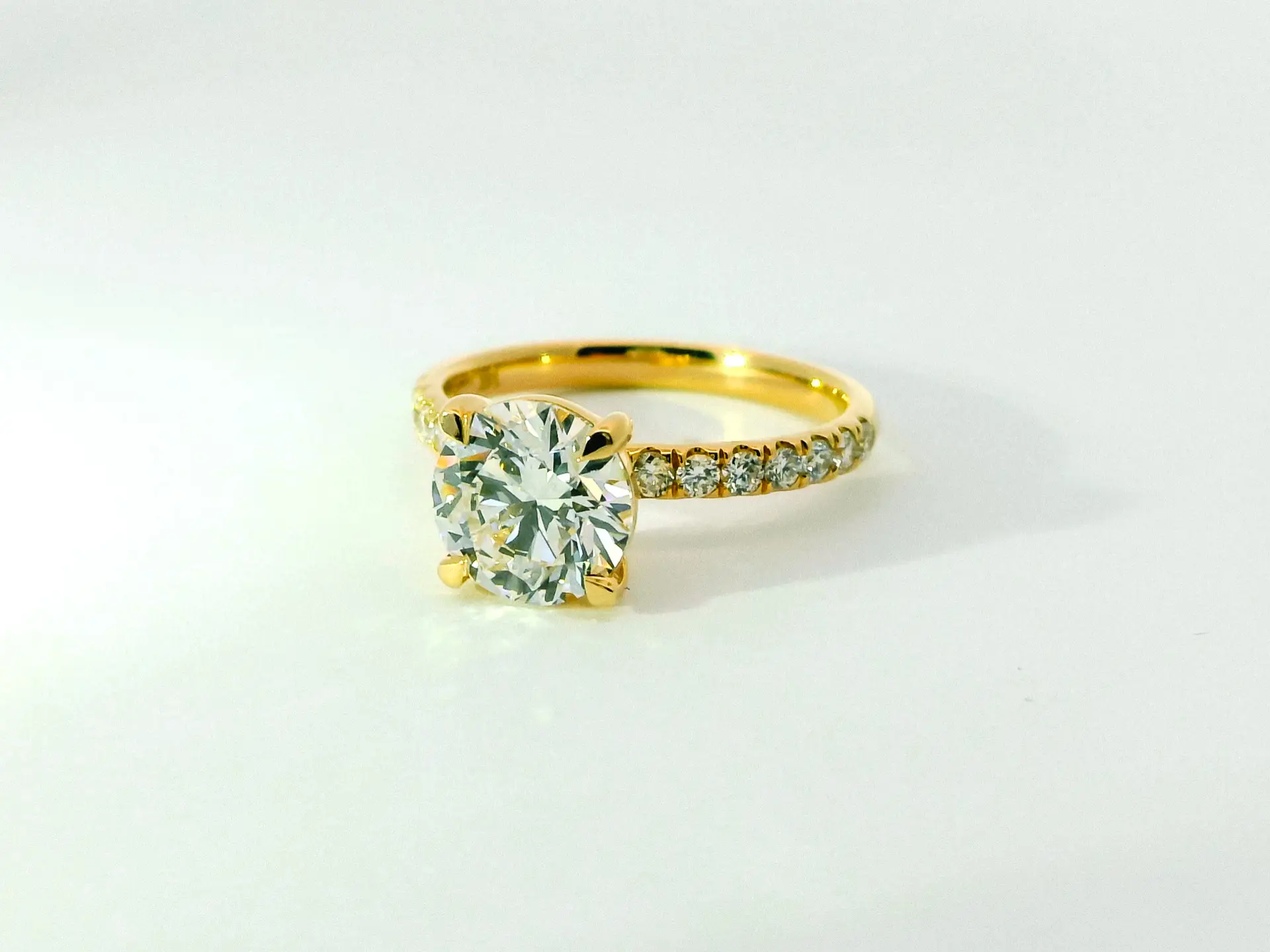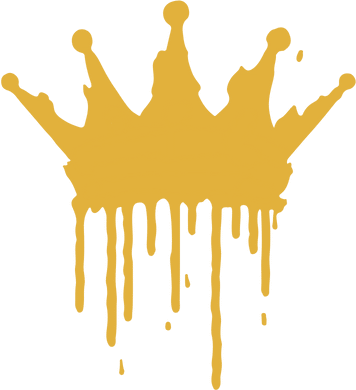
Gabrielle’s Ideals for Round Brilliant Diamonds
(Table: 54–60% (56–58%), Depth: 59–62.5% (60-61%), Pavilion Depth: 42–45% (43%), Pavilion Angle: 40–41.2° (40.2°–41.25°), Crown Angle: 34–35° (33.7°–35.8°), Crown Height: 12–15%, Girdle: 2.5–4.5%)
The round brilliant cut is the most meticulously engineered diamond shape, designed to optimize light return for maximum brilliance, fire, and scintillation. With 58 facets (or 57 if there’s no culet), this cut is mathematically calculated to achieve perfect symmetry and ideal light reflection when cut correctly.
Developed in 1919 by Marcel Tolkowsky, a Belgian mathematician and gem cutter, the round brilliant cut was the first diamond shape to be scientifically optimized for light performance. Tolkowsky introduced the ideal cut formula, which remains the foundation for modern diamond cutting. Over the past century, the round brilliant has been refined even further, making it the most studied and perfected cut in diamond history.
1. What Is a Round Brilliant Cut Diamond? #
A round brilliant diamond is built for maximum sparkle. Its brilliant-cut facet structure is designed to capture light, bounce it through the stone, and return it back to the viewer’s eye as a dazzling display of brightness and fire.
This shape is also the most forgiving regarding inclusions and color, as its brilliance masks imperfections better than step cuts or elongated shapes.
Why Choose a Round Brilliant Diamond?
-
Brightest & Most Sparkling Cut:
Precision-engineered for maximum light return.
-
Timeless & Versatile:
The most classic diamond shape, working with every setting style and aesthetic.
-
Optimized Light Performance:
A well-cut round balances brilliance (white light), fire (rainbow dispersion), and scintillation (sparkle movement).
-
Hides Inclusions & Color Well:
The brilliant facet pattern helps disguise inclusions and slight tints better than most other shapes.
Potential Downsides of a Round Brilliant Diamond
-
Higher Price per Carat:
Due to the significant waste generated during the cutting process, round brilliants are more expensive per carat than many fancy shapes.
-
Sensitivity to Proportions:
The round brilliant’s beauty hinges on precise proportions. Even minor deviations in table, depth, or facet angles can significantly affect fire, brilliance, and scintillation.
-
Commonality:
As the most popular diamond shape, round brilliants might feel less unique if you’re looking for a distinctive or unconventional style.
-
Apparent Size:
Although optimized for light return, round brilliants can sometimes appear slightly smaller than elongated shapes (like ovals or marquises) when comparing the same carat weight.
-
Cut Quality Variability:
Since the light performance depends on the cut, inconsistencies between different cutters or grading labs can result in variations in brilliance, even among stones with similar proportions.
 #
#
2. The 4Cs for a Round Brilliant Lab Diamond #
While the 4Cs—Cut, Color, Clarity, and Carat—are essential for any diamond, the cut is paramount for round brilliants because it directly influences how light is managed within the stone.
Cut – The Heart of Round Brilliance
Getting the cut right means dialing in these key proportions:
-
Table Percentage (IGI’s ideals: 54–60% | Gabrielle’s Ideals: 56–58%):
The table is the largest, flat facet on the top of the diamond. A well-proportioned table allows light to enter evenly, enhancing both fire and overall brilliance.
-
Depth Percentage (IGI’s ideals: 59–62.5% | Gabrielle’s Ideals: 60.0-60.9%):
Depth is the measure of the diamond’s height relative to its width. Maintaining an ideal depth ensures that light isn’t lost—if the diamond is too shallow, light escapes; too deep, and light becomes trapped.
-
Pavilion Depth (IGI’s ideals: 42–45% | Gabrielle’s Ideals: 43%):
The pavilion is the bottom portion where internal reflections occur. An optimal pavilion depth helps maximize light return, giving the diamond its exceptional sparkle.
-
Pavilion Angle (IGI’s ideals: 40–41.2° | Gabrielle’s Ideals: 40.2°–41.25°):
This angle directs light from the table through the diamond, playing a crucial role in producing brilliance and scintillation.
-
Crown Angle (IGI’s ideals: 34–35° | Gabrielle’s Ideals: 33.7°–35.8°; 34° preferred):
The crown’s angle influences the light dispersion, with the ideal range helping to enhance the stone’s fire while maintaining overall brightness.
-
Crown Height (12–15%) & Girdle (2.5–4.5%):
These factors contribute to the diamond’s appearance and durability, ensuring that the stone looks stunning and withstands everyday wear.
Pro Tip: Think of the table and pavilion as the dynamic duo that controls fire and brilliance, while the depth and crown work together to manage light dispersion. Minor deviations in one area can be balanced by precision in another, resulting in a perfectly harmonious stone.
Color – Enhancing the Icy Sparkle
Round brilliants are cut to bring out a bright, white appearance. Selecting the right color grade enhances the diamond’s natural sparkle:
-
D–F (Colorless): Icy-white, crisp, and ideal for platinum/white gold settings.
-
G–H (Near Colorless): The best value—appears white in most lighting.
-
I–J: Slight warmth may be visible, but works well in yellow or rose gold settings.
Pro Tip: In settings featuring yellow or rose gold, an H–J color grade can work wonderfully, as the metal helps mask any slight warmth. Otherwise, a F or G color grade will still appear bright white in a brilliant cut.
Clarity – Focus on Structural Integrity
Lab diamonds typically feature fewer inclusions. For round brilliants, aim for eye-clean clarity to ensure that nothing detracts from the stone’s luminous performance:
-
VS1–VS2: The sweet spot—excellent clarity and value with no visible inclusions at a casual glance.
-
SI1–SI2: Acceptable if the inclusions remain invisible to the naked eye.
-
VVS1–VVS2: Nearly flawless, though these come at a premium.
-
F–IF: Flawless diamonds exist, but they are generally not necessary for most buyers.
Pro Tip: A VS1–VS2 clarity diamond usually provides the best balance between beauty and affordability for everyday wear.
Carat – More Size for Your Budget
Lab diamonds enable you to opt for larger stones without compromising on quality. However, remember that a well-cut diamond with ideal proportions will always appear more brilliant (therefore, it will appear larger) than a physically higher carat weight stone with inferior proportions.
Pro Tip: Always prioritize cut quality over carat size—a perfectly proportioned 1.50 ct round brilliant will look larger and more dazzling than a poorly cut 1.75 ct stone.
3. Additional Considerations #
Symmetry & Polish
-
Symmetry: Excellent symmetry ensures the diamond reflects light evenly for an elegant, well-proportioned appearance.
-
Polish: Excellent or very good polish is the best choice to maximize the crispness and cleanliness of the facets.
Fluorescence
-
None or Faint fluorescence is ideal, as strong fluorescence can cause haziness in some diamonds.
Certification
-
Always buy IGI- or GIA-certified diamonds to ensure accurate grading.
Setting Considerations
-
Metal Choice:
-
Platinum/white gold enhances brightness.
-
Yellow/rose gold can mask warmth in H-J color diamonds.
-
-
Best Settings:
-
Six-prong solitaires maximize security.
-
If you have a 4-prong, please ensure you include a gallery rail to protect your stone!
-
-
Halo settings enhance perceived size.
-
Bezel settings offer protection but slightly reduce sparkle.
-
Final Thoughts #
A well-cut round brilliant diamond is the brightest, most refined shape available. It’s timeless, versatile, and optimized for maximum brilliance and fire. By following Gabrielle’s ideals, you can confidently select a sparkling, high-performing round diamond that balances precision, beauty, and durability.
Happy diamond hunting—may your round brilliant diamond shine as brilliantly as you do!


